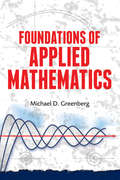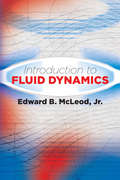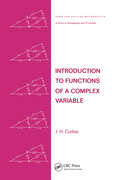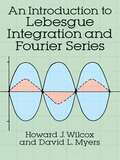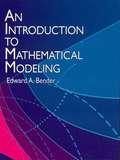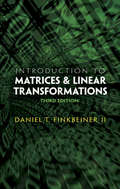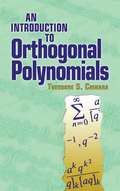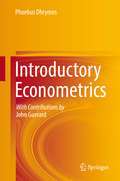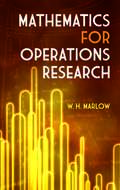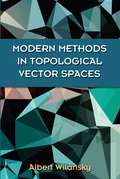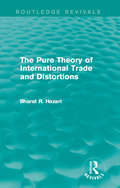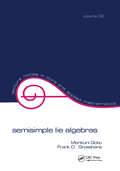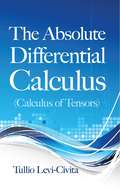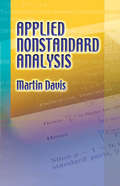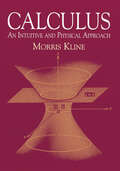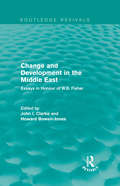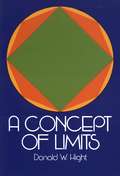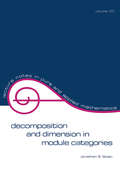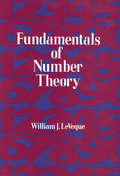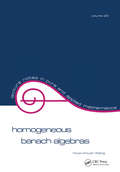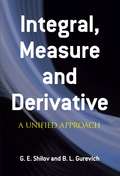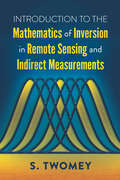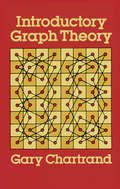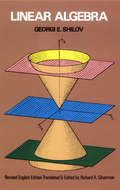- Table View
- List View
Foundations of Applied Mathematics
by Michael D. GreenbergThis classic text in applied mathematics, suitable for undergraduate- and graduate-level engineering courses, is also an excellent reference for professionals and students of applied mathematics. The precise and reader-friendly approach offers single-volume coverage of a substantial number of topics along with well-designed problems and examples. The five-part treatment begins with an exploration of real variable theory that includes limit processes, infinite series, singular integrals, Fourier series, and vector field theory. Succeeding sections examine complex variables, linear analysis, and ordinary and partial differential equations. Answers to selected exercises appear in the appendix, along with Fourier and Laplace transformation tables and useful formulas.
An Introduction To Braille Mathematics: Based On The Nemeth Braille Code For Mathematics And Science Notation, 1972
by Helen Roberts Bernard Marvin Krebs Barbara Taffet Abraham Nemeth Library Of Congress National Library Service for the Blind and Physically Handicapped Staff<P><P><i>Advisory: Bookshare has learned that this book offers only partial accessibility. We have kept it in the collection because it is useful for some of our members. Benetech is actively working on projects to improve accessibility issues such as thesse.</i>
Introduction to Fluid Dynamics
by Edward B. Mcleod Jr.Concise, unified, and logical, this introduction to the study of the basic principles of fluid dynamics emphasizes the statement of problems in mathematical language. In addition to its value as a reference for professional engineers, this volume is suitable for advanced undergraduates and graduate students of mathematics and engineering. Some familiarity with the algebra of vector fields is assumed, and a useful appendix provides a succinct review of vector algebra.An introductory chapter covers fundamental notions from the continuum hypothesis to steady-state flow. Succeeding chapters explore conservation of mass, forces acting on a fluid in equilibrium, dynamic equations of motion, irrotational motion, integration of Euler's equation in special cases, and flows representable by harmonic functions. Additional topics include two dimensional flows, rectilinear vortices, general vortex motion, flows with a free boundary, and compressible fluids.
Introduction to Functions of a Complex Variable (Chapman And Hall/crc Pure And Applied Mathematics Ser. #44)
by J. H. CurtissThis book includes information on elementary general topology, the Cauchy Integral Theorem and concepts of homology and homotopy in their application to the Cauchy theory. It is intended for an introductory course in complex analysis at the first-year graduate and advanced undergraduate level.
An Introduction to Lebesgue Integration and Fourier Series (Dover Books on Mathematics)
by David L. Myers Howard J. WilcoxThis book arose out of the authors' desire to present Lebesgue integration and Fourier series on an undergraduate level, since most undergraduate texts do not cover this material or do so in a cursory way. The result is a clear, concise, well-organized introduction to such topics as the Riemann integral, measurable sets, properties of measurable sets, measurable functions, the Lebesgue integral, convergence and the Lebesgue integral, pointwise convergence of Fourier series and other subjects.The authors not only cover these topics in a useful and thorough way, they have taken pains to motivate the student by keeping the goals of the theory always in sight, justifying each step of the development in terms of those goals. In addition, whenever possible, new concepts are related to concepts already in the student's repertoire.Finally, to enable readers to test their grasp of the material, the text is supplemented by numerous examples and exercises. Mathematics students as well as students of engineering and science will find here a superb treatment, carefully thought out and well presented , that is ideal for a one semester course. The only prerequisite is a basic knowledge of advanced calculus, including the notions of compactness, continuity, uniform convergence and Riemann integration.
An Introduction to Mathematical Modeling (Dover Books on Computer Science)
by Edward A. BenderEmploying a practical, "learn by doing" approach, this first-rate text fosters the development of the skills beyond the pure mathematics needed to set up and manipulate mathematical models. The author draws on a diversity of fields -- including science, engineering, and operations research -- to provide over 100 reality-based examples. Students learn from the examples by applying mathematical methods to formulate, analyze, and criticize models. Extensive documentation, consisting of over 150 references, supplements the models, encouraging further research on models of particular interest. The lively and accessible text requires only minimal scientific background. Designed for senior college or beginning graduate-level students, it assumes only elementary calculus and basic probability theory for the first part, and ordinary differential equations and continuous probability for the second section. All problems require students to study and create models, encouraging their active participation rather than a mechanical approach. Beyond the classroom, this volume will prove interesting and rewarding to anyone concerned with the development of mathematical models or the application of modeling to problem solving in a wide array of applications.
Introduction to Matrices and Linear Transformations: Third Edition
by Daniel T. Finkbeiner IIThis versatile undergraduate text can be used in a variety of courses in linear algebra. It contains enough material for a one-year course, and it also serves as a support text and reference. A combination of formal theory and related computational techniques, it includes solutions to selected exercises. 1978 edition.
An Introduction to Orthogonal Polynomials (Dover Books On Mathematics Ser.)
by Theodore S ChiharaAssuming no further prerequisites than a first undergraduate course in real analysis, this concise introduction covers general elementary theory related to orthogonal polynomials. It includes necessary background material of the type not usually found in the standard mathematics curriculum. Suitable for advanced undergraduate and graduate courses, it is also appropriate for independent study. Topics include the representation theorem and distribution functions, continued fractions and chain sequences, the recurrence formula and properties of orthogonal polynomials, special functions, and some specific systems of orthogonal polynomials. Numerous examples and exercises, an extensive bibliography, and a table of recurrence formulas supplement the text.
Introductory Econometrics
by Phoebus DhrymesThis book has taken form over several years as a result of a number of courses taught at the University of Pennsylvania and at Columbia University and a series of lectures I have given at the International Monetary Fund. Indeed, I began writing down my notes systematically during the academic year 1972-1973 while at the University of California, Los Angeles. The diverse character of the audience, as well as my own conception of what an introductory and often terminal acquaintance with formal econometrics ought to encompass, have determined the style and content of this volume. The selection of topics and the level of discourse give sufficient variety so that the book can serve as the basis for several types of courses. As an example, a relatively elementary one-semester course can be based on Chapters one through five, omitting the appendices to these chapters and a few sections in some of the chapters so indicated. This would acquaint the student with the basic theory of the general linear model, some of the prob#65533; lems often encountered in empirical research, and some proposed solutions. For such a course, I should also recommend a brief excursion into Chapter seven (logit and pro bit analysis) in view of the increasing availability of data sets for which this type of analysis is more suitable than that based on the general linear model.
Mathematics for Operations Research
by W. H. MarlowThis practical, applications-oriented text demonstrates the key role of mathematics in optimization and linear systems. It explains effective procedures for performing mathematical tasks that arise in many fields, including operations research, engineering, systems sciences, statistics, and economics. Readers will learn how to resolve linear independence and find null spaces and factors of matrices, determine existence of restricted solutions to linear equations and inequalities, and resolve definiteness of Hermitian and real symmetric matrices by Gaussian pivoting. Additional topics include how to diagonalize — or "nearly" diagonalize — square matrices, differentiate vectors and matrices by the chain rule, solve systems of differential and difference equations, and other subjects. Most of the examples and many of the 1,300 problems illustrate techniques, and nearly all of the tables display reference material for procedures. Differential and integral calculus are prerequisites.
Modern Methods in Topological Vector Spaces (Dover Books on Mathematics)
by Albert WilanskyDesigned for a one-year course in topological vector spaces, this text is geared toward advanced undergraduates and beginning graduate students of mathematics. The subjects involve properties employed by researchers in classical analysis, differential and integral equations, distributions, summability, and classical Banach and Frechét spaces. Optional problems with hints and references introduce non-locally convex spaces, Köthe-Toeplitz spaces, Banach algebra, sequentially barrelled spaces, and norming subspaces.Extensive introductory chapters cover metric ideas, Banach space, topological vector spaces, open mapping and closed graph theorems, and local convexity. Duality is the treatment's central theme, highlighted by a presentation of completeness theorems and special topics such as inductive limits, distributions, and weak compactness. More than 30 tables at the end of the book allow quick reference to theorems and counterexamples, and a rich selection of problems concludes each section.
The Pure Theory of International Trade and Distortions (Routledge Revivals)
by Bharat HazariFirst published in 1978. This book provides a simple, systematic, yet rigorous treatment of the key aspects of the pure theory of international trade and distortions. The opening chapter presents the standard two-factor, two-commodity barter model of international trade and a comprehensive treatment of the important properties and relationships. The rest of the book consists of four sections: parts One and Two are devoted to an analysis of factor market imperfections, and Parts Three and Four consider the trade-theoretical consequences of product market imperfections. A concluding chapter presents some generalised theorems. This book would be of interest to students of economics.
Semisimple Lie Algebras
by Morikuni Goto Frank D. GrosshansThis book provides an account of part of the theory of Lie algebras most relevant to Lie groups. It discusses the basic theory of Lie algebras, including the classification of complex semisimple Lie algebras, and the Levi, Cartan and Iwasawa decompositions.
The Absolute Differential Calculus: Calculus Of Tensors (Dover Books on Mathematics)
by Tullio Levi-CivitaWritten by a towering figure of twentieth-century mathematics, this classic examines the mathematical background necessary for a grasp of relativity theory. Tullio Levi-Civita provides a thorough treatment of the introductory theories that form the basis for discussions of fundamental quadratic forms and absolute differential calculus, and he further explores physical applications.Part one opens with considerations of functional determinants and matrices, advancing to systems of total differential equations, linear partial differential equations, algebraic foundations, and a geometrical introduction to theory. The second part addresses covariant differentiation, curvature-related Riemann's symbols and properties, differential quadratic forms of classes zero and one, and intrinsic geometry. The final section focuses on physical applications, covering gravitational equations and general relativity.
Applied Nonstandard Analysis
by Prof. Martin DavisGeared toward upper-level undergraduates and graduate students, this text explores the applications of nonstandard analysis without assuming any knowledge of mathematical logic. It develops the key techniques of nonstandard analysis at the outset from a single, powerful construction; then, beginning with a nonstandard construction of the real number system, it leads students through a nonstandard treatment of the basic topics of elementary real analysis, topological spaces, and Hilbert space.Important topics include nonstandard treatments of equicontinuity, nonmeasurable sets, and the existence of Haar measure. The focus on compact operators on a Hilbert space includes the Bernstein-Robinson theorem on invariant subspaces, which was first proved with nonstandard methods. Ever mindful of the needs of readers with little background in these subjects, the text offers a straightforward treatment that provides a strong foundation for advanced studies of analysis
Calculus: An Intuitive and Physical Approach (Second Edition) (Dover Books on Mathematics)
by Morris KlineApplication-oriented introduction relates the subject as closely as possible to science. In-depth explorations of the derivative, the differentiation and integration of the powers of x, and theorems on differentiation and antidifferentiation lead to a definition of the chain rule and examinations of trigonometric functions, logarithmic and exponential functions, techniques of integration, polar coordinates, much more. Clear-cut explanations, numerous drills, illustrative examples. 1967 edition. Solution guide available upon request.
Change and Development in the Middle East: Essays in honour of W.B. Fisher (Routledge Revivals)
by John I. Clarke and Howard Bowen-JonesThe Middle East is a region of great traditional diversity, which has been characterized by immense political, social and economic changes, still developing over thirty years after the title’s original publication. A group of oil-rich countries have achieved great political significance and some of the highest per capita incomes in the world. Much modern development has been spatially polarized, accentuating the concentrations of rapidly growing populations and posing severe problems for planners. Cultivation and pastoralism, the main traditional activities, have often suffered from neglect and insufficient investment, and both require re-evaluation. These are the issues addressed by this volume, first published in 1981, which contains a series of overviews and case studies written by present or former members of staff and research students of the Department of Geography in the University of Durham in honour of W.B. Fisher. Change and Development in the Middle East provides an interesting and relevant geographical and demographic analysis of this diverse and volatile region.
A Concept of Limits (Dover Books on Mathematics)
by Donald W. HightAn exploration of conceptual foundations and the practical applications of limits in mathematics, this text offers a concise introduction to the theoretical study of calculus. It analyzes the idea of a generalized limit and explains sequences and functions to those for whom intuition cannot suffice. Many exercises with solutions. 1966 edition.
Decomposition and Dimension in Module Categories (Lecture Notes In Pure And Applied Mathematics Ser. #33)
by Jonathan S. GolanThis book examines the notions of dimension and decomposition for module categories. It discusses some basic properties of quasidecomposition functions and the complete lattice of all quasidecomposition functions taking values in a fixed given lattice.
Fundamentals of Number Theory
by William J. LevequeThis excellent textbook introduces the basics of number theory, incorporating the language of abstract algebra. A knowledge of such algebraic concepts as group, ring, field, and domain is not assumed, however; all terms are defined and examples are given -- making the book self-contained in this respect.The author begins with an introductory chapter on number theory and its early history. Subsequent chapters deal with unique factorization and the GCD, quadratic residues, number-theoretic functions and the distribution of primes, sums of squares, quadratic equations and quadratic fields, diophantine approximation, and more. Included are discussions of topics not always found in introductory texts: factorization and primality of large integers, p-adic numbers, algebraic number fields, Brun's theorem on twin primes, and the transcendence of e, to mention a few.Readers will find a substantial number of well-chosen problems, along with many notes and bibliographical references selected for readability and relevance. Five helpful appendixes -- containing such study aids as a factor table, computer-plotted graphs, a table of indices, the Greek alphabet, and a list of symbols -- and a bibliography round out this well-written text, which is directed toward undergraduate majors and beginning graduate students in mathematics. No post-calculus prerequisite is assumed. 1977 edition.
Homogeneous Banach Algebras
by Hwai-Chiuan WangThis book examines some aspects of homogeneous Banach algebras and related topics to illustrate various methods used in several classes of group algebras. It guides the reader toward some of the problems in harmonic analysis such as the problems of factorizations and closed subalgebras.
Integral, Measure and Derivative: A Unified Approach
by G. E. Shilov B. L. GurevichThis graduate-level textbook and monograph defines the functions of a real variable through consistent use of the Daniell scheme, offering a rare and useful alternative to customary approaches. The treatment can be understood by any reader with a solid background in advanced calculus, and it features many problems with hints and answers. "The exposition is fresh and sophisticated," declared Sci-Tech Book News, "and will engage the interest of accomplished mathematicians." Part one is devoted to the integral, moving from the Reimann integral and step functions to a general theory, and obtaining the "classical" Lebesgue integral in n space. Part two constructs the Lebesgue-Stieltjes integral through the Daniell scheme using the Reimann-Stieltjes integral as the elementary integral. Part three develops theory of measure with the general Daniell scheme, and the final part is devoted to the theory of the derivative.
Introduction to the Mathematics of Inversion in Remote Sensing and Indirect Measurements (Developments In Geomathematics Ser. #Volume 3)
by S. TwomeyIn this graduate-level monograph, S. Twomey, a professor of atmospheric sciences, develops the background and fundamental theory of inversion processes used in remote sensing — e.g., atmospheric temperature structure measurements from satellites—starting at an elementary level.The text opens with examples of inversion problems from a variety of disciplines, showing that the same problem—solution of a Fredholm linear integral equation of the first kind — is involved in every instance. A discussion of the reduction of such integral equations to a system of linear algebraic equations follows. Subsequent chapters examine methods for obtaining stable solutions at the expense of introducing constraints in the solution, the derivation of other inversion procedures, and the detailed analysis of the information content of indirect measurements. Each chapter begins with a discussion that outlines problems and questions to be covered, and a helpful Appendix includes suggestions for further reading.
Introductory Graph Theory
by Gary ChartrandGraph theory is used today in the physical sciences, social sciences, computer science, and other areas. Introductory Graph Theory presents a nontechnical introduction to this exciting field in a clear, lively, and informative style. Author Gary Chartrand covers the important elementary topics of graph theory and its applications. In addition, he presents a large variety of proofs designed to strengthen mathematical techniques and offers challenging opportunities to have fun with mathematics. Ten major topics -- profusely illustrated -- include: Mathematical Models, Elementary Concepts of Graph Theory, Transportation Problems, Connection Problems, Party Problems, Digraphs and Mathematical Models, Games and Puzzles, Graphs and Social Psychology, Planar Graphs and Coloring Problems, and Graphs and Other Mathematics. A useful Appendix covers Sets, Relations, Functions, and Proofs, and a section devoted to exercises -- with answers, hints, and solutions -- is especially valuable to anyone encountering graph theory for the first time. Undergraduate mathematics students at every level, puzzlists, and mathematical hobbyists will find well-organized coverage of the fundamentals of graph theory in this highly readable and thoroughly enjoyable book.
Linear Algebra
by Georgi E. ShilovCovers determinants, linear spaces, systems of linear equations, linear functions of a vector argument, coordinate transformations, the canonical form of the matrix of a linear operator, bilinear and quadratic forms, Euclidean spaces, unitary spaces, quadratic forms in Euclidean and unitary spaces, finite-dimensional space. Problems with hints and answers.
